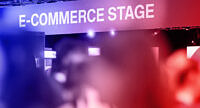Digital advertising is booming – a lasting trend or one-peak wonder?
At DMEXCO @home, the German Association for the Digital Economy (BVDW) presented the latest figures for digital advertising in its trend monitor for online media. One thing that stood out: online marketing revenues shot up rapidly in 2020.

Nearly all economic sectors suffered financial losses at the start of the pandemic. As a result, companies reduced their advertising budgets. That was particularly noticeable in the first two quarters of 2020. However, there was a turnaround in the second half of the year: advertising spending soared. But how long will this trend continue?
Upward trend from the pandemic continuing in 2021
2020 was no easy year for many industries. Companies all over the world had to overcome the unprecedented challenges of a pandemic never experienced before. For the digital advertising sector however, the IAB revenue report reveals an impressive increase of 12.2 percent when viewed as a whole.
The success of 2020 can be mainly attributed to Q4, which demonstrated year-over-year growth of 28.7 percent. That’s the highest on record in 20 years.
Search, social media, content, video, and audio ads: Q4 2020 exceeded advertising revenue growth across all formats.
According to the agency Zenith, the upward trend is continuing in 2021. An increase of 13 percent is expected for the U.S. sector, which has already been growing unabated since 2019 and accounts for nearly half of the global market’s advertising revenues overall. China comes in second at 11 percent. It is anticipated that the digital advertising revenues generated globally in 2021 will rise from 463.8 billion US dollars to almost 633 billion US dollars by 2025.
At DMEXCO @home, the Circle of Online Marketers (OVK) of the German Association for the Digital Economy (BVDW) presented its latest trend monitor for online media. According to the monitor, the sharp upward trend is being mirrored on the German market, where demand for online advertising among clients has more than doubled in 2021 compared to last year. 60 percent of the surveyed agencies said that their customers are increasingly embracing digital media. The OVK expects growth of 23.4 percent in 2021 for the display advertising market.
Did lockdown give digital marketing a push?
This question is also answered in the OVK’s study: the pandemic has enormously accelerated the shift of media and retail toward the Internet. Office and computer equipment, tourism, food, and cosmetics are the sectors that have profited the most. E-commerce sales are growing, and advertising budgets are thus being allocated more to digital advertising.
Buying behavior has quickly adapted to the conditions brought about by the exceptional situation. For many of us, online shopping became an alternative and even a habit in place of in-store shopping during lockdown. Video conferences and the popularity of Zoom were proof that business can also be done via video chat. SMEs consequently also discovered the potential of the Internet as an advertising platform and learned to appreciate the opportunities of online marketing. That all led to marketers increasingly moving their advertising messages to digital platforms.
One thing’s for sure: advertising spending is becoming more digitally focused – and this trend is irreversible.
Strong growth is also expected to continue in the digital industry, even if it may not be as rapid as during the pandemic.
New ad formats gaining ground
Digital in-store advertising, addressable TV, digital audio, and digital out of home are the emerging advertising formats that will become more and more attractive in the future. The ever-broader range of ATV and podcasts is causing a shift in the types of media being consumed most frequently – and thus a shift in advertising formats. Audio saw advertising revenue growth of 3.1 billion US dollars in 2020, nearly 400 million US dollars more than 2019. The majority of that was generated through placements on mobile devices.
Most agencies that took part in the BVDW’s survey also think that these formats could continue to grow for the next five years.
Video ads, search, and social media are winning
Video and social media saw the largest year-over-year increases. According to the IAB Internet Advertising Revenue Report, social media advertising revenues reached 41.5 billion US dollars in 2020. Having grown by 16.3 percent compared to the previous year, social media accounts for nearly 30 percent of all online advertising revenues. That is also due to booming online retail, which, going forward, will lead to an added revenue boost on the advertising market and likely further increase the share of social media.
Revenues in the digital video segment also rose rapidly. Video ads on mobile devices and desktops experienced growth of over 20 percent last year. The total advertising revenues generated from digital videos have increased by 4.5 billion to 26.2 billion US dollars since 2019. At 70 percent. mobile accounts for the majority of digital video revenues and continues to grow.
However, digital advertising in search engines is still the most popular advertising format, having achieved 59 billion US dollars of revenue in 2020 – an increase of 7.8 percent. 42.2 percent of total Internet advertising is thus attributed to search.
But Google and the like are definitely no longer the only contenders when it comes to ad platforms. Buyers are now searching directly for products in the search engines of e-retailers. The traffic from these attractive advertising spaces is forwarded directly to the brand or the product pages hosted by the e-retailer. In this respect as well, marketing strategies have been significantly influenced by how the pandemic has changed the buying and consumption behavior of users.
Programmatic advertising is booming – but for how long still?
Programmatic advertising and cookies mean that users are taken to the seemingly perfect product as if by magic. Customer-oriented tracking as the basis for the customer journey is a booming marketing tool. And it’s not hard to see why. After all, digital advertising budgets can be spent in a more targeted and efficient way when they are aligned with individual user behavior.
Programmatic advertising revenues increased by 14.2 billion US dollars in 2020, which corresponds to growth of nearly 30 percent.
Amid this massive boom, the calls for better data protection and greater privacy are getting louder and louder. That in turns raises the question whether this growth can be maintained.
Anti-tracking policies: a new challenge for marketers
The cookie banners appearing on almost every website no longer have much to do with genuine data protection. Just because users automatically click on them, it doesn’t mean that they are consciously consenting to cookie functions.
Big players like Google and Facebook are already responding to the issue by reducing web tracking. Apple, for example, introduced Intelligent Tracking Prevention some time ago to restrengthen the trust between the company and its users. The marketing technologies implemented by adtech providers are thus being put to the test: do they respect the privacy of the target group and still manage to reach it? Over 90 percent of those surveyed as part of the trend monitor are worried that the European digital industry will be left behind by the big U.S. corporations – and also by Asian providers in the longer term.
In the future, both global players and smaller companies will be confronted with the challenge of targeting their customers even without third-party cookies while at the same time still ensuring that the customer journey is a valuable experience.
Blocking third-party tracking is forcing companies to learn how to profitably use big data in real time and based on the individual behavior of users. Contextual intelligence could be the solution here. This technology identifies qualitative content on the net, paving the way for precise targeting and brand safety. Especially in an era of fake news, a safe advertising environment is becoming more and relevant for brands and companies wanting to emphasize their purpose and sustainability.




